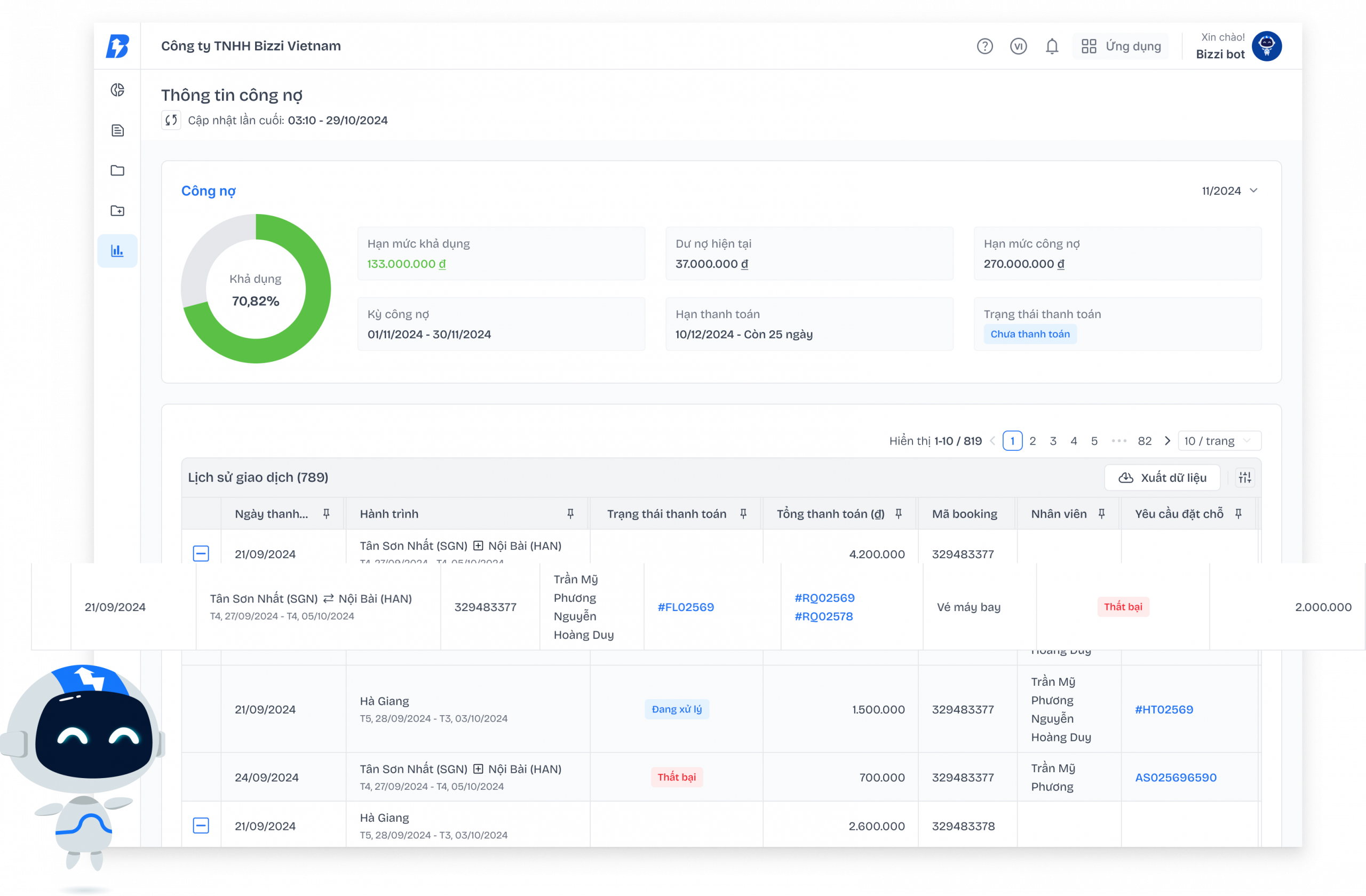Interest expense is a major item that every business that uses borrowed capital must face. It is not only the payment for the use of capital but also a tool financial leverage has a strong impact on profits and overall financial health. In the context of increasingly strict tax regulations, mastering the nature, accounting methods and management strategies interest expense is a mandatory requirement to ensure legal compliance and optimize operational efficiency.
In this article, Bizzi will help you understand What is interest expense?, recording principles and detailed accounting methods according to Vietnamese accounting standards. Let's find out to ensure your business operates in accordance with regulations and optimize costs!
1. Overview of interest costs
Understanding interest expense is an important factor in corporate financial management, especially when using borrowed capital to develop production, business or investment activities. The following section will help you grasp the concept, nature and role of interest expenses in financial report.
1.1 What is interest expense?
Interest expense (Interest Expense) is the financial cost that a business must pay for using capital mobilized from lenders such as bank, credit institutions or individuals. On the income statement, this item (Code 23) represents the interest incurred during the period, recorded in Account 635, not necessarily the actual amount of interest paid.

1.2 The nature and core characteristics of interest expenses
In essence, interest expense is the price of using other people's capital. It carries with it important core attributes that every manager needs to master:
- Obligation: This is one debt obligation legal as specified in credit agreement. Businesses must pay on time regardless of profit or loss.
- Periodicity: This cost is incurred and recorded periodically (monthly, quarterly), creating a constant pressure on cash flow.
- Debt-driven: Only arises when the business has an account liabilities, it is a direct consequence of capital structure decisions.
- Volatility: Costs may vary depending on interest rate market (especially with floating rate loans), is directly affected by the monetary policy of State Bank of Vietnam.
- Deductibility: This is the most important feature. Interest expense valid will generate a Tax Shield, helping to reduce corporate income tax of enterprises.
1.3 Types of interest expenses
Interest expenses in business can be classified as follows:
- Short term interest: Interest expense arises from loans with terms of less than 12 months, typically used to supplement working capital or meet short-term financial needs.
- Long term interest: Interest expense from loans with terms of more than 12 months, usually used for investment in fixed assets or long-term projects.
- Overdraft interest: Interest expenses arise when a business uses more than the bank account balance according to the granted credit limit.
- Bond and convertible debt interest rates: Interest costs associated with the issuance of bonds or convertible debt.
- Financial costs of finance lease assets: Interest expense related to leasing assets under finance leases.
2. Impact of interest costs on businesses
Interest expense is the amount of money a business must pay for the use of borrowed capital over a certain period of time. Effective management of interest expenses plays an important role in maintaining the financial health and competitiveness of a business.
Impact on business results
Interest expense is part of financial expenses, directly affecting the profits of enterprises. When interest expense increases, after-tax profits decrease, affecting the ability to reinvest and develop. Especially, in the period of high market interest rates, enterprises face greater cost pressure, leading to narrowed profits.
Impact on product, goods and service prices
Interest expenses are included in the cost of products, goods and services. When interest expenses increase, product costs also increase, affecting competitiveness in the market. Therefore, controlling interest expenses helps businesses maintain reasonable prices and improve their competitive position.
Impact on solvency
Interest expense is a fixed expense that a business must pay periodically. If this expense accounts for a large proportion of total expenses, the business may encounter cash flow difficulties, affecting the ability to pay other financial obligations. Effective control of interest expense helps manage current money in business stable and solvency

Impact on financial risk
Using borrowed capital with high interest costs increases financial leverage, which means increasing financial risks. Enterprises may face the risk of insolvency if they do not manage their loans and related costs well. Especially in volatile economic conditions, controlling financial risks from interest costs is very important.
Impact on corporate income tax
According to regulations, interest expenses are deductible when calculating corporate income tax, but there are certain limits. Specifically, the total deductible interest expenses must not exceed 30% of the total net profit from business operations plus interest expenses and depreciation expenses incurred during the period. Therefore, reasonable management of interest expenses helps optimize tax obligations and avoid related legal issues.
3. Legal regulations on interest expenses 2025
Interest expense is the financial expense that a business must pay for the use of borrowed capital in its business operations. The determination and deduction of interest expense when calculating corporate income tax (CIT) is strictly regulated in Vietnamese law. In 2025, the Government issued Decree 20/2025/ND-CP amending and supplementing a number of articles of Decree 132/2020/ND-CP, in order to update and adjust regulations related to tax management for businesses with related-party transactions.
3.1 Interest expense in related party transactions
Related party transactions occur when enterprises have special relationships with each other in terms of capital, management or control, leading to the ability to influence the prices and profits of the participating parties. To control transfer pricing and ensure transparency in tax declarations, Decree 20/2025/ND-CP has provided specific regulations on interest expenses in related party transactions.
Accordingly, the total net interest expense (after deducting deposit interest and loan interest) deductible when determining taxable income of CIT shall not exceed 30% of the total net profit from business activities plus net interest expense and depreciation expense incurred during the period. The portion of interest expense exceeding this level may be carried forward to the next tax period, with the transfer period not exceeding 5 consecutive years from the year following the year in which the non-deductible interest expense arose.
3.2 Interest expense when settling corporate income tax
When settling corporate income tax, enterprises need to pay attention to the regulations on interest expenses to ensure the reasonableness and validity of deductible expenses. For interest expenses incurred before 2024 but not yet deducted, Decree 20/2025/ND-CP allows enterprises to allocate these expenses evenly to the following tax periods, based on the remaining transition period, to minimize financial impacts and support enterprises in complying with tax regulations.
Compliance with regulations on interest expenses not only helps businesses optimize tax obligations but also ensures transparency and legal compliance in financial activities. Therefore, accountants and business owners need to regularly update changes in changes in tax policy to apply effectively and avoid legal risks.
4. Formula for calculating interest costs
Understanding how to calculate helps businesses be proactive in financial planning. The most popular method today is to calculate interest on Decreasing balance.
4.1 Calculating bank interest costs
The reducing balance method of calculating interest is based on the actual amount owed after deducting the principal paid in previous periods.
The formula for calculating bank loan interest rates when borrowing capital is usually applied according to the decreasing balance, the calculation formula is as follows:
Interest payable (Month) = Current loan balance x Loan interest rate x Actual number of days maintaining balance / 365

4.2 Calculating interest costs for individuals, businesses, and other organizations
Interest expense is calculated based on the current outstanding balance, interest rate (monthly/yearly) and actual loan tenure. The formula for calculating total interest payable is as follows:
Interest payable = Monthly interest + Odd-day interest
In there:
- Interest paid monthly = Current loan balance × Loan interest rate (year) × Actual number of days maintaining outstanding balance / 365
- Interest paid daily = Current loan balance × Loan interest rate (year) × Actual number of days maintaining odd balance per month / 365
For example: The business borrows 1 billion VND, interest rate 12%/year (ie 1%/month), principal payment is 100 million/month.
- January interest: 1,000,000,000 x 1% = 10,000,000 VND
- February interest (remaining debt 900 million): 900,000,000 x 1% = 9,000,000 VND
5. How to account for interest expenses
Interest expense is a financial expense incurred when business loans from credit institutions or individuals to serve business operations. Accurately accounting for interest expenses helps businesses manage finances effectively and comply with tax regulations. Below are detailed instructions on how to account for reasonable interest expenses, capitalize interest expenses, and unreasonable interest expenses.
5.1 Interest expense
Interest expenses are considered reasonable and deductible when calculating corporate income tax (CIT) if they meet the following conditions:
- Loan purpose: Loans are used for the business operations of the enterprise.
- Loan interest rate: Not exceeding 150% the basic interest rate announced by the State Bank of Vietnam at the time of borrowing.
- Contribute charter capital: The enterprise has contributed enough charter capital according to the schedule stated in the company charter.
When reasonable interest expenses arise, accounting is as follows:
In case of periodic interest payment:
- Debit account 635 – Financial expenses
- Credit account 111, 112 – Cash or Bank deposit
In case of paying interest in advance for many periods:
When paying interest:
- Debit account 242 – Prepaid expenses
- Credit account 111, 112 – Cash or Bank deposit
Allocate interest expense to each accounting period:
- Debit account 635 – Financial expenses
- Credit account 242 – Prepaid expenses
5.2 Capitalization of interest expenses
Capitalization of borrowing costs is the recording of borrowing costs arising during the investment in construction or production of unfinished assets into the value of that asset. According to Accounting Standard No. 16 - Borrowing costs, borrowing costs are capitalized when:
- Borrowing costs that are directly attributable to the acquisition, construction or production of a qualifying asset.
- The enterprise is certain to gain future economic benefits from the use of that asset.
- Borrowing costs can be measured reliably.
When capitalized interest expenses arise, accountants record:
For construction investment activities:
- Debit account 241 – Construction in progress
- Credit account 111, 112 – Cash or Bank deposit
- Credit account 335 – Expenses payable (if interest is paid in arrears)
For the production of unfinished assets:
- Debit account 627 – General production costs
- Credit account 111, 112 – Cash or Bank deposit
- Credit account 335 – Expenses payable (if interest is paid in arrears)
Note: Capitalization of borrowing costs ceases when the activities necessary to prepare the asset for its intended use or sale are completed. Subsequent borrowing costs are recognized as operating expenses in the period.
5.3. Handling non-deductible interest expenses
Although not deductible when calculating corporate income tax, accountants must still fully account for these expenses in the books (usually account 635). At the end of the period, when preparing the corporate income tax finalization declaration (Form 03/TNDN), accountants will make adjustments and remove these expenses at B4 indicator.
6. How to handle unreasonable interest expenses
Interest expense Interest expense is the expense that a business must pay for using borrowed capital for production and business activities. However, not all interest expenses are considered reasonable and deductible when calculating corporate income tax (CIT). Identifying and properly handling unreasonable interest expenses is very important to ensure compliance with legal regulations and optimize the tax obligations of the business.
6.1. Criteria for determining unreasonable interest expenses
According to Circular 96/2015/TT-BTC, some cases where interest expenses are not deductible when calculating corporate income tax include:
- Charter capital not fully contributed: In case the enterprise has not contributed enough charter capital according to the registered schedule, the interest expense corresponding to the missing charter capital will not be deducted. For example, if the enterprise borrows 1 billion VND with an interest rate of 10%/year and still lacks 300 million VND in charter capital in 5 months, the non-deductible interest will be 300 million VND x 10%/12 months x 5 months = 12.5 million VND.
- Loan interest rate exceeds 150% base interest rate: If the enterprise borrows at an interest rate higher than the 150% base interest rate announced by the State Bank at the time of borrowing, the excess interest will not be included in the reasonable expenses.
- Loans not for production and business activities: Interest expenses for loans not used for the business's production and business activities will not be deductible.
- Large cash balance but still borrowing capital: If a business has a large cash balance but still borrows, the tax authority may review and exclude this interest expense because it considers the borrowing unreasonable.
6.2. Unreasonable way of accounting for interest expenses
Although unreasonable interest expenses are not deductible when calculating corporate income tax, enterprises still need to fully account for them to accurately reflect their financial situation:
When paying interest:
- Debit account 811: Other expenses
- Credit account 111, 112: Cash or bank deposit
At the end of the period, carry over costs:
- Debit account 911: Determine business results
- Credit account 811: Other expenses
Note that these expenses will not be deducted when determining taxable income for corporate income tax.
6.3. Declaration and adjustment on corporate income tax finalization declaration
At the end of the year, when preparing the corporate income tax finalization declaration (form No. 03/TNDN), the enterprise needs to:
- Determine the total amount of unreasonable interest expense during the period.
- Enter this total into cell B4. (“Non-deductible expenses when determining taxable income”) on the tax finalization declaration.
This ensures that unreasonable expenses are excluded from taxable income, in compliance with tax laws.
6.4. Solutions to limit the occurrence of unreasonable interest costs
To avoid unreasonable interest expenses, businesses should:
- Contribute charter capital fully and on time according to business registration
- Build a reasonable financial plan, avoid borrowing capital when not really necessary, especially when the business has excess cash.
- Ensure reasonable loan interest rates, not exceeding 150% base interest rate announced by the State Bank.
- Use loan for the right purpose, serving the production and business activities of the enterprise.
Proper management and accounting of unreasonable interest expenses will help businesses comply with legal regulations, optimize tax obligations and improve financial management efficiency.
7. Interest expenses are deductible when calculating corporate income tax.
Not all interest expense are all included in reasonable expenses when determining taxable income. Enterprises need to understand the provisions of tax law to determine the portion of interest expenses that can be deducted when calculating corporate income tax (CIT). Below are some common accepted cases:
7.1. Interest on loans from individuals shall not exceed 150% base interest rate of the State Bank of Vietnam.
When a business borrows capital from an individual, the interest expense is deductible when calculating corporate income tax if the interest rate does not exceed 150% the basic interest rate announced by the State Bank of Vietnam at the time of borrowing. If the interest rate exceeds this level, the excess interest expense will not be included in the deductible expenses.
7.2. Interest on loans corresponding to the fully contributed charter capital
Enterprises are only allowed to deduct interest expenses when they have fully contributed their charter capital according to the registered schedule. If they have not fully contributed their charter capital, the interest expense corresponding to the remaining charter capital will not be included in the deductible expenses.
Specifically, if the loan amount is less than or equal to the remaining charter capital, the entire loan interest is a non-deductible expense. If the loan amount is greater than the remaining charter capital, it is necessary to determine the non-deductible interest rate based on the charter capital that has not been fully contributed.
7.3. 30% Net EBITDA Limit for Related Party Transactions
For enterprises with related-party transactions, the total interest expense (after deducting deposit interest and loan interest) deductible when determining taxable income of CIT shall not exceed 30% of the total net profit from business activities in the period, plus interest expense and depreciation expense incurred in the period. The portion of interest expense that is not deductible may be carried forward to the next tax period, but the transfer period shall not exceed 5 years.
8. Effective interest expense management strategy
With solution Bizzi expense management, businesses can build a professional process to control and optimize interest expense.
- Optimizing capital structure: Reasonable balance between debt and equity to take advantage of financial leverage without pushing financial risk up too high
- Cash Flow & EBITDA Planning: Proactively forecast cash flow and EBITDA to control the 30% ceiling, avoiding passive cost exclusion.
- Complete legal documents: Use Bizzi's digital storage system to ensure all contracts and payment documents are always ready and complete when needed. tax authority check.
- Choose a smart financial partner: Compare interest rates, hidden fees and choose a reputable lender with flexible loan terms.
- Contribute full charter capital on time: This is a prerequisite to avoid incurring additional charges. interest expense unreasonable

Conclude
Interest expense is not only an accounting item but also a key factor determining the financial performance of a business. Understanding how to account for and optimize this cost will help businesses better control cash flow, increase profits and ensure sustainable development.
If you are looking for flexible financial solutions, Bizzi Financing helps businesses easily access suitable capital, even without collateral. Discover now:
Read more:


